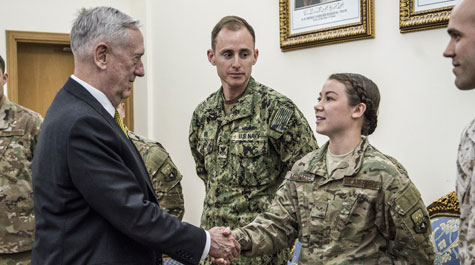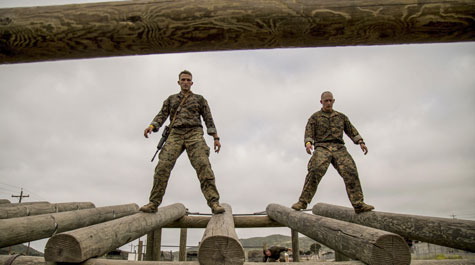Former W&M fellow speaks to how the all-volunteer military can be sustained
Military, government and academic experts on the United States Armed Forces spoke to a crowd of about 100 at the second annual All-Volunteer Force Symposium April 27 at William & Mary’s Sadler Center.
The event was a continuation of the 2016 debate that focused on the evaluation of the United States’ capacity to maintain an all-volunteer military due to high budgetary costs, according to Lawrence B. Wilkerson, distinguished adjunct professor of government and public policy at W&M and the symposium’s coordinator.
“We’re here today because it is imperative to the people of the United States to know if the model of their all-volunteer force is fair and ethical,” he said. “It happened at Kansas University last year, and it's going to happen here at William & Mary this year. This symposium will not just be you, [the audience] asking panel members questions and listening to their answers, but this will be your opportunity to offer your insight and your experienced-based understanding as to where the AVF should go.”
Among this year’s speakers were retired U.S. Army Reserve Maj. Gen. Dennis Laich, U.S. Army Col. Brian R. Formy-Duval and Professor Emeritus of International Relations and History Andrew J. Bacevich of Boston University.
However, active duty U.S. Army Col. Stephanie Gradford, a former U.S. Army War College fellow in William & Mary’s public policy program, possibly set the tone of the day’s conference.
According to Gradford, the AVF as a concept is fine as it is, but to strengthen existing weaknesses and to minimize the civilian-to-military gap, Americans within certain age brackets should be required to serve in some capacity.
“In 2015 as an academic fellow here at William & Mary, I was given a topic to research from the Chief of Staff of the U.S. Army’s Key Strategic Initiatives List and almost immediately, I took as my topic model of the All-Volunteer Force,” she said. “To prevent the military from lowering its accessioning standards such as moral criteria like felony convictions and physical fitness problems of potential recruits, I suggested that a ‘universal national service program’ be implemented. This new system means that there would be mandatory service to include all American citizens, between the ages of 18 and 25. Such service would begin with rigorous background examinations and physical suitability tests after which individuals would then serve in fields such as the military, law enforcement, the Peace Corps and Teach for America. Then, if a draft is needed, our military can recruit from those ready and applicable sources.”
In addition to creating a ready pool of applicants for military service, Gradford indicated that two current areas of concern in the current model need to be examined: the Defense Department’s use of civilian contractors and the method of using select types of pay to attract and keep service members. These funds could be used instead to fund the national service programs, she said.
Civilian contractors
“In 2015, the America troop presence in Afghanistan went down from 32,000 personnel to about 9,800,” Gradford said. “To get around this diminished number, the DOD began increasing the number of contractors in-theater. As of 2016, there is a three-to-one ratio or nearly 29,000 contractors working with fewer than 9,000 U.S. troops working in Afghanistan. The money used to fund contractors could theoretically be used to subsidize the universal national service program.”
According to the Congressional Review Service, the DOD has long relied on contractors to provide the U.S. military with a broad range of goods and services. Civilian contractors’ expertise includes weapons maintenance, vehicles, food service, uniform cleaning and operational support such as facility upkeep.
In the fiscal year 2015, the DOD obligated more money on federal contracts of about $274 billion — which is $283 billion adjusted for inflation in the fiscal year 2017 — than all other federal government agencies combined. Without contractor support, the United States would be currently unable to arm and field an effective fighting force, the CRS stated.
Special Incentive Pays
The other facet of concern regarding the AVF, according to Gradford, is the military’s use of enlistment and reenlistment bonuses to draw and keep personnel from leaving military service.
The Military Times, a non-DOD affiliated magazine that tracks news and information about the U.S. military, states that each service offers a bonus to enlist or reenlist. The bonuses range from $8,000 to $150,000, depending on the specialty of the individual.
“Money should not be the driving factor to serve in the United States’ military,” she said. “It would be an amazing cost-saving measure to reallocate those resources could to help create and maintain the universal national service program.”
These particular disbursements also include assignment incentive, hazardous duty incentive and hardship duty pay. For example, nuclear-engineers serving on board submarines or aircraft carriers, those carrying out special operations and technical experts such as those with high proficiencies in foreign languages like Farsi and Pashto and satellite communication repair experience, according to the Times.
In her closing remarks, Gradford reiterated that the AVF model is fine as it is but needs attention from military and civilian leaders. She also stated that her recommendations would come with pushback from the public throughout the United States.
“I’d like to stress that the AVF is fine,” she said. “[The U.S. military’s] job is to defend, fight and win wars on behalf of this nation, and we are doing that. Readdressing the viability of the AVF will not be an easy task, but I believe by constricting the military’s current use of civilian contractors and eliminating reenlistment and enlistment bonuses could bring about adequate budgetary savings that could help the Department of Defense run more efficiently.”




















